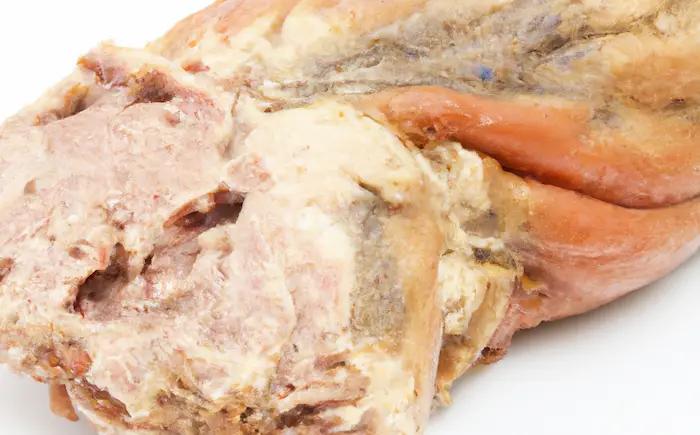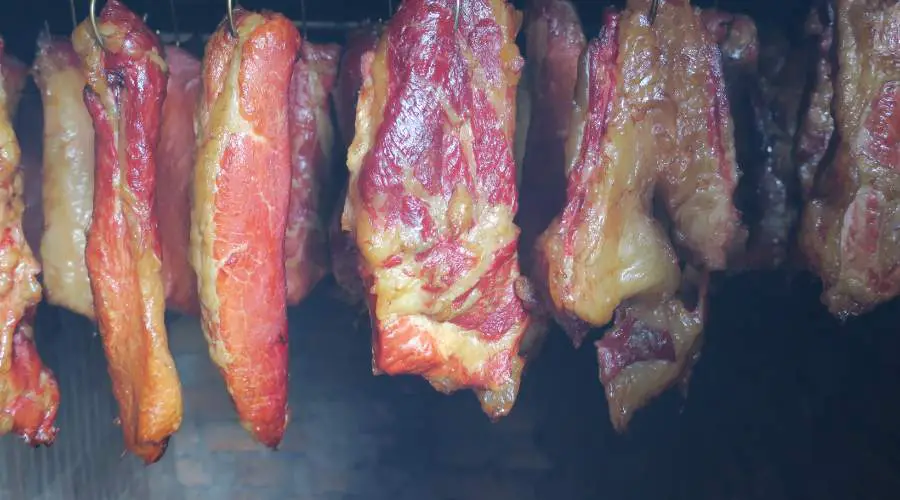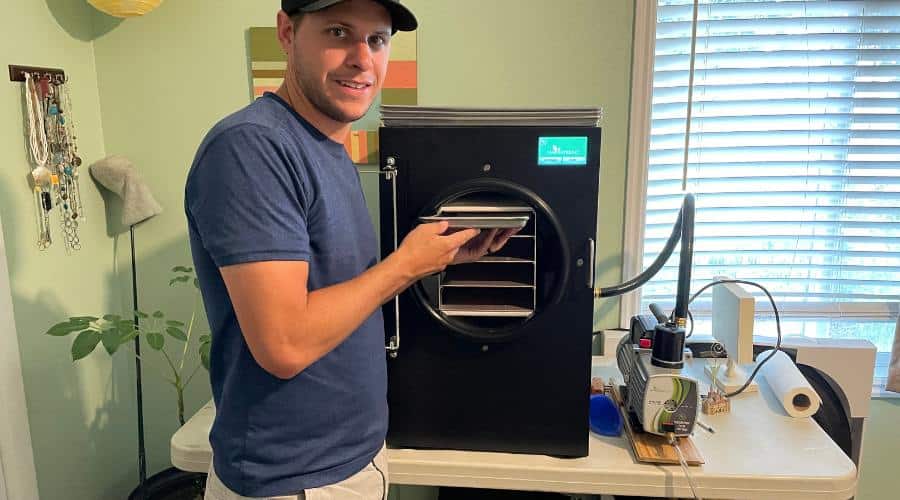Meat is an essential part of our diet, providing us with essential nutrients and protein. However, keeping meat fresh for a long time can be a challenge, especially if you don’t have access to a refrigerator. But don’t worry! There are several ways to store meat without refrigeration that will keep it fresh for an extended period.
In this article, we will explore the various methods for storing meat without refrigeration and how to choose the best one for your needs. See a full list of foods that last a long time without refrigeration.
If you are interested in buying beef in bulk see if it’s worth it for you, an insider’s guide to buying beef in bulk at a discount, and 6 tips for storing beef long-term.
Understanding the Science of Meat Preservation
To understand how to store meat without refrigeration, it’s essential to understand the science behind meat preservation. It is crucial to know what factors that affect the shelf life of food.
How Does Meat Go Bad?
Meat can go bad due to a variety of reasons, including:
- Growth of harmful bacteria
- Enzymes breaking down the meat
- Exposure to air and light
One of the most common causes of spoilage in meat is the growth of bacteria. Bacteria naturally exist on meat and can grow rapidly if the meat is not stored properly. Bacteria can cause the meat to spoil and develop an off odor and flavor, as well as make it unsafe to eat.
Another factor that can cause meat to spoil is the action of enzymes that naturally occur in the meat. These enzymes break down the proteins and fats in the meat, leading to spoilage and changes in the texture, flavor, and appearance of the meat.
Exposure to air and light can also cause meat to spoil. When meat is exposed to air, oxidation occurs, which can cause the meat to develop an off flavor and discoloration. Exposure to light can also cause discoloration in meat, as well as encourage the growth of bacteria.
It is important to store meat properly and to be aware of any signs of spoilage, such as an off odor, discoloration, or changes in texture, to ensure that it is safe to eat. If there are any signs of spoilage, it is best to discard the meat.

Preventing Meat From Going Bad
To prevent meat from going bad, it’s crucial to control things like the temperature, humidity, and air exposure of the meat. Preservation methods prevent the growth of harmful bacteria and slow the enzymes that breakdown the meat. Consider the following factors to help prevent meat spoilage:
- Temperature: Keeping meat at low temperatures, below 40°F, slows down the growth of bacteria and other pathogens that can cause spoilage.
- Humidity: Maintaining low humidity levels helps prevent mold and bacteria growth.
- Oxygen: Preventing oxygen exposure, by vacuum sealing or other methods, helps prevent oxidation, which can cause meat to spoil.
- Salt: Curing meat with salt can help prevent spoilage by slowing down the growth of bacteria. Salt also helps draw moisture out of the meat, making it a less hospitable environment for bacteria to grow.
- Acid: Adding an acidic ingredient, such as vinegar or citric acid, can help preserve meat by lowering the pH, making it difficult for bacteria to grow.
- Sugar: Adding sugar to meat, as in a marinade or brine, can help preserve it by drawing moisture out of the meat and creating a less hospitable environment for bacteria to grow.
- Smoking: Smoking meat can help preserve it by creating a smoke environment that is inhospitable to bacteria and other pathogens, while also adding flavor.
- Preservation Techniques: Using preservation techniques such as vacuum sealing, freeze drying, or pressure canning can help prevent spoilage by removing oxygen or moisture and creating a barrier against bacteria and other pathogens.
It’s important to note that while these factors can help prevent spoilage, they should be used in combination with safe food handling practices to ensure that the meat remains safe to eat.
Traditional Methods for Meat Preservation
There are several traditional methods for preserving meat without refrigeration, including salting, smoking, and drying. These methods have been used for centuries to extend the shelf life of meat and are still popular today.
Curing
Curing is a traditional method for preserving meat that has been used for centuries. This method involves the use of salt, sugar, and other seasonings to draw moisture out of the meat and prevent bacteria growth. The meat is then left to cure for several days or weeks, depending on the type of meat and the desired flavor (NCHFP).
Cured meat has a distinct, salty flavor and is often used in the production of ham, bacon, and other cured meats. Curing is a relatively simple process that can be done at home with basic equipment, making it a popular choice for those who want to preserve their own meat.
Drying
Drying is a traditional method that involves hanging meat in a warm, dry place for several days or weeks, allowing it to lose moisture and prevent bacteria growth. The dried meat can then be stored for several months or even years, depending on the type of meat and the drying conditions.
Drying is a relatively simple and low-cost method for preserving meat, and it has been used by cultures all over the world. The process of drying meat involves cutting it into thin slices or strips and hanging it in a warm, dry place with good ventilation. This allows the meat to lose moisture and prevent bacteria growth, resulting in a dried product that is both flavorful and long-lasting.

One of the benefits of drying meat is that it is relatively easy to do and requires only a few basic materials. You can dry meat in a sunny spot on your porch or in a warm room with good ventilation, and the process can be done in just a few days. Additionally, dried meat is lightweight and easy to transport, making it a great option for those who are looking to preserve their food for travel or for long-term storage.
The easiest way to dry meat is to purchase and use a food dehydrator. There are many good options out there that are simple to use and do the job well but choosing the right one can be challenging. To make selecting the right meat dehydrator easy see the best food dehydrators. Also, to get a better idea what what they can do see a full list of what you can and cannot dehydrate.
Drying is an effective method for preserving meat, and it has been used for centuries by cultures all over the world. If you are looking to preserve your own meat using traditional methods, consider drying as a simple and delicious option.
Smoking
Smoking meat involves exposing it to smoke from burning wood chips. This method works by adding flavor to the meat while also preserving it. The smoke contains a natural preservative called nitrates, which helps to prevent bacteria growth. Smoking is best suited for beef, pork, and fish, and can be done in a smoker, or even on a grill.

Raw Packing
Raw packing is a traditional method for preserving meat that involves packing meat in salt or a salt brine. This method works by drawing moisture out of the meat, creating an environment that is hostile to bacteria growth. The meat is then stored in a cool, dry place for several months, allowing it to cure and develop a unique flavor.
Raw packing is a relatively simple method for preserving meat, and it has been used for centuries in many cultures. However, it requires careful attention to sanitation and storage conditions, as improper storage can result in spoilage and food poisoning.
If you are interested in preserving your own meat using traditional methods, raw packing is definitely worth considering. With its simplicity and delicious results, it is a great choice for those who want to preserve their own food.
Also, see complete guides on how to store these common types of food storage items:
Modern Methods for Meat Preservation
In addition to traditional methods, there are several modern methods for preserving meat without refrigeration. These methods are designed to be more convenient and easier to use, making them ideal for those who want to store meat for an extended period without the need for refrigeration.
Freeze Drying
Freeze drying is a modern method for preserving meat that has gained popularity in recent years. This method works by removing all the moisture from the meat through a process of sublimation. The meat is placed in a vacuum-sealed chamber and subjected to low temperatures and pressure. This causes the moisture to change from a solid to a gas without passing through the liquid stage, effectively preserving the meat for a long period.
Freeze-dried meat has several benefits over other preservation methods. Firstly, it is lightweight and compact, making it easy to store and transport. Secondly, it has a long shelf life, with some brands claiming that their freeze-dried meat can last for 15 years or longer (see how to store freeze-dried food). Finally, it retains the flavor, texture, and nutritional value of the fresh meat.

Freeze drying meat requires specialized equipment, so it may not be an option for everyone (see if a freeze dryer is worth it for you). However, if you are looking for a convenient, long-term storage solution, freeze drying may be the way to go. Freeze-dried meat is available in various forms, including whole cuts, ground meat, and pre-packaged meals, and can be purchased online or at specialty food stores.
Vacuum Sealing
Vacuum sealing is a modern method for preserving meat that involves removing air from a plastic bag and sealing it tightly around the meat. This prevents bacteria growth and slows down the spoilage process, allowing the meat to last for several months in the freezer.
It’s important to note that vacuum sealed meat cannot be stored at room temperature, as this will promote the growth of harmful bacteria and spoil the meat (USDA). Instead, vacuum sealed meat should be stored in a freezer, where it will maintain its freshness and quality for a longer period. This is because the low temperatures in the freezer slow down the spoilage process and prevent bacteria from growing.
Vacuum sealing is a convenient and efficient method for preserving meat, and it is widely available online or at kitchenware stores (see if a vacuum sealer is worth it for you). The equipment required for vacuum sealing is relatively affordable, and the process is quick and straightforward. If you’re looking for a modern, convenient method for preserving your meat, vacuum sealing is definitely worth considering.

Pressure Canning
Canning is another modern method for preserving meat that involves placing the meat in jars, adding a liquid, and sealing the jars shut. This method works by creating a vacuum-sealed environment that helps to prevent bacteria growth and extend the shelf life of the meat.
To store meat using this method, you will need a pressure canner, which can be purchased online or at a local kitchenware store (see if a pressure canner is worth it for you). Also, it is helpful to know what can and cannot be pressure canned.
Please make sure you follow reputable recipes and instructions when pressure canning to make sure you avoid harmful bacteria like those associated with botulism. See instructions and recipes from the National Center for Home Food Preservation.
Choosing the Right Method for Your Needs
Choosing the right method for storing meat long-term without refrigeration will depend on several factors, such as the type of meat, personal preferences, and the conditions of storage. Here are some guidelines to help you choose the right method for you:
- Type of Meat: Different methods of preservation may be better suited for different types of meat. For example, curing is a good option for fatty meats like bacon and ham, while drying is better suited for lean cuts of meat like jerky.
- Personal Preferences: Consider your personal preferences, such as taste, texture, and the desired outcome of the preservation process. Some methods, like smoking or raw packing, can affect the flavor and texture of the meat.
- Storage Conditions: Consider the conditions under which the meat will be stored, such as temperature, humidity, and exposure to air and light. Some methods, like vacuum sealing, may be better suited for storage in a cool, dry place, while others, like drying, may be better suited for storage in a hot and dry environment.
- Safety: Safety is a crucial factor to consider when choosing a method for storing meat. Methods like pressure canning and vacuum sealing are considered to be the safest methods for long-term storage without refrigeration, as they are effective at preventing the growth of bacteria and other pathogens.
- Equipment: If you have the desire and funds to purchase a freeze dryer (see if a freeze dryer is worth it for you) then freeze drying is a great method for preserving and storing any type of meat for 15 years or longer without a refrigerator. You can also purchase various freeze dried meats online that store for years at room temperature although they can be expensive compared to other preserved meats. See our favorite freeze dried foods that you can buy online and try out and see a full list of what can and cannot be freeze dried.
It is important to thoroughly research each method of preservation and to consider all of these factors before making a decision. In some cases, it may be necessary to try a few different methods to find the one that works best for you and your specific needs.
FAQs
How long can you store meat without refrigeration?
The length of time that you can store meat without refrigeration depends on the method you use. Salted meat can last for several months, while meat that has been vacuum-sealed can last for up to a year.
What is the best method for preserving meat without refrigeration?
The best method for preserving meat without refrigeration depends on your specific needs and preferences. Vacuum sealing and freezing is a convenient and efficient option, while canning is a more traditional method that is ideal for long-term storage. Also, freeze drying, dehydrating, and curing are all great options depending on if you have access to the equipment and have the knowledge to do it correctly.
Can you store raw meat without refrigeration?
Yes, you can store raw meat without refrigeration, but it’s essential to use a preservation method that will prevent bacteria growth and keep the meat safe to eat such as curing, drying, raw packing, canning, or freeze drying.
What meat lasts longest without refrigeration?
Freeze-dried meat is one of the types of meat that can last the longest without refrigeration. This is because the freeze-drying process removes moisture from the meat, which is one of the main factors that contribute to spoilage. When stored in airtight containers in a cool, dry place, and with oxygen absorbers, freeze-dried meat can retain its quality and taste for several years.
What type of meat is best suited for salting?
Beef, pork, and fish are the best types of meat for salting or curing.
Can you smoke meat without a smoker?
Yes, you can smoke meat without a smoker by using an oven, or gill with wood chips, however these methods may have varying results.
What is the shelf life of cured meat?
The shelf life of cured meat can range from several weeks to several months, depending on the specific curing method used. The shelf life of cured meat can be extended by proper storage and by monitoring it regularly for signs of spoilage.
Conclusion
Storing meat without refrigeration can be a challenge, but with the right method, you can keep your meat fresh for an extended period. Whether you choose a traditional method, like salting or smoking, or a modern method, like vacuum sealing or canning, it’s essential to understand the science behind meat preservation and choose the method that best fits your needs.


